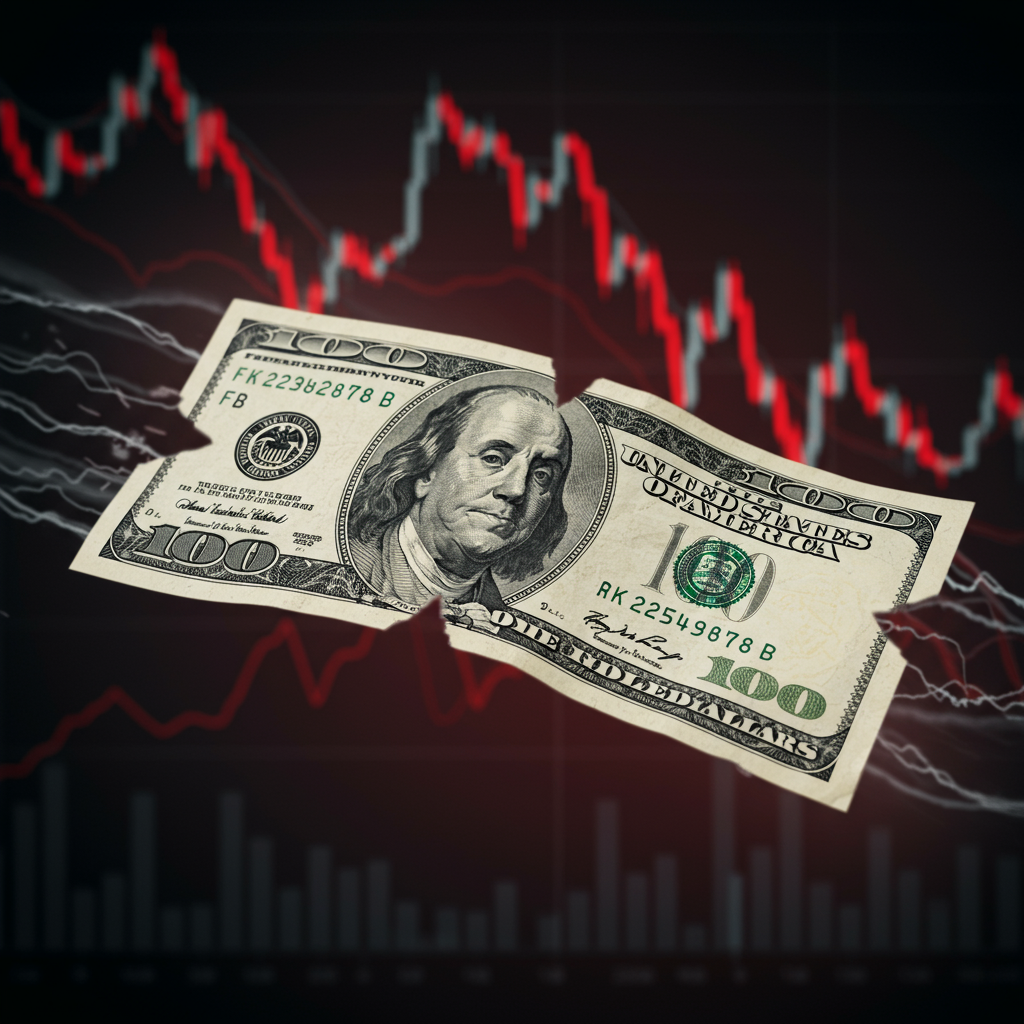The U.S. dollar is experiencing a dramatic decline, setting the stage for potentially its worst year on record in modern history. This significant weakening marks a pivotal moment for the global economy and America’s role within it, largely driven by shifts in U.S. economic policy and mounting investor uncertainty. Currency markets, typically stable havens, are now reflecting a turbulent period characterized by rapid policy changes and growing concerns over national debt.
Decoding the dollar’s Dramatic Drop
The numbers tell a stark story of the dollar’s slide. In the first half of 2025 alone, the U.S. dollar fell by more than 10%, marking its most significant drop for the opening six months of a year since 1973. This also positions it for the weakest six-month performance seen since 2009. Comparing the current trend to the period immediately following the end of the gold-backed Bretton Woods system underscores the magnitude of this depreciation. The widely tracked dollar index (DXY), which measures the greenback against six major currencies including the euro and yen, has tumbled, falling more than 10% year-to-date and over 13% from its 52-week high. Experts, like those at Morgan Stanley, even project the dollar could see an additional drop of up to 10% before the year concludes, suggesting the volatility may persist.
Policy Shocks Fueling Instability
Analysts largely attribute this sharp downturn to the impact of President Donald Trump’s economic policies. Described by some as the “whipping boy of Trump 2.0’s erratic policies,” the dollar appears sensitive to the administration’s unpredictable approach. Key factors include the “start-pause tariff war” and the broader uncertainty generated by rapid trade policy overhauls. These shifts have created unease among global investors. Furthermore, concerns over rising U.S. debt levels are heavily influencing sentiment. Specific legislative actions, such as a major tax and spending bill recently passed by Republicans, which is projected to add trillions to the national debt over the next decade, have exacerbated these worries and reportedly contributed to an exodus from the U.S. Treasury market.
Beyond the Exchange Rate: Global Economic Shifts
The dollar’s performance is not occurring in a vacuum. It reflects broader questions about America’s position in the global economic structure. Some observers view the U.S. as facing an “inflection point,” perceiving it as a less fully trusted ally or a less reliable financial haven due to factors like ballooning budget deficits and political instability. Despite these concerns, a common sentiment among global investors remains “There is no alternative,” or TINA. This perspective persists because the U.S. still boasts the world’s deepest capital markets, most dynamic companies, and a notably resilient workforce. While worries exist, foreigners collectively still hold trillions in U.S. assets, and finding viable alternative destinations for such vast sums presents significant challenges. As one expert put it, the U.S. remains a “safe asset, but at a different price.” This challenging environment suggests the global economy may be transitioning from a U.S.-centric “hub-and-spoke” model to a more complex, less efficient, and potentially more expensive “point-to-point” system defined by bilateral negotiations and trade friction.
The Dollar’s Soft Power Under Pressure
The pronounced decline in the dollar’s value naturally raises a more fundamental question: Is the dollar’s long-held role as the central currency of the global financial system truly under threat? The current instability has certainly put its traditional “safe-haven” status under pressure. While efforts towards de-dollarization are noted globally – including central banks increasing gold reserves and countries like China utilizing currency swap lines with developing nations – experts caution that these actions have not yet fundamentally altered the dollar’s dominant position. Political economist Ngaire Woods has previously argued that the dollar’s historical centrality has been protected by sound U.S. government policies and active global engagement. The current period of policy unpredictability and perceived retreat from global norms tests this premise.
Market Turmoil and the Currency Fallout
The volatility seen in the dollar has rippled across other financial markets, creating widespread turmoil. During the first 100 days of President Trump’s second term, markets struggled significantly. The S&P 500 index saw a notable decline, positioning it for one of its worst post-inaugural slumps in decades. This unexpected performance followed years of strong gains and was directly linked to the imposition of tariffs and shifting trade policies. The Treasury market, typically a bastion of stability, experienced dramatic swings, with yields initially falling as investors sought safety from tariff announcements, only to reverse sharply due to fears of a trade-war induced recession. Corporate debt markets also faced a meltdown, experiencing their worst period since the pandemic began as borrowing became more difficult and risk gauges surged. Even the crypto market, specifically Bitcoin, saw a significant sell-off, posting its worst monthly performance in years amid the broader market weakness. This market turbulence contrasts sharply with the performance of traditional safe havens like gold, which rallied significantly during this period of uncertainty, setting new all-time highs. While U.S. markets faced headwinds, other major currencies performed relatively well against the dollar. The euro, for instance, gained substantially, rising over 13%, defying earlier predictions of reaching parity. The British pound also saw gains, while even the Japanese yen appreciated significantly against the weaker dollar. Mixed U.S. economic data, including cooling inflation signals alongside a notable drop in consumer spending potentially linked to anxiety over future tariff-driven price hikes, further contributed to the market’s volatile state throughout this period.
Historical Parallels and Future Uncertainty
Comparing the current dollar depreciation to 1973 offers valuable historical perspective. That period was also marked by significant currency instability and famously culminated in the U.S. abandoning the gold standard. Experts point out that substantial movements in the dollar’s value, both up and down, tend to be associated with moments of broader economic or political instability. Today’s environment, characterized by rising jingoism and protectionist tendencies globally, complicates U.S. trade negotiations and relationships. Trading partners face the challenge of balancing domestic political pressures with the need to maintain stable relations with the U.S. economy. The current scenario of a significantly weaker dollar, coupled with unpredictable policy and global fragmentation, leaves investors and policymakers grappling with considerable uncertainty about the future trajectory of currency markets and the global financial architecture.
Frequently Asked Questions
Why is the US dollar performing so poorly recently?
The U.S. dollar’s significant decline is primarily linked to uncertainty surrounding U.S. economic policies, particularly those related to trade and government spending. Policies like unpredictable tariffs and concerns over rapidly increasing national debt, partly fueled by recent legislation, are eroding investor confidence and putting pressure on the dollar’s traditional status as a safe investment. Geopolitical factors and mixed domestic economic data also contribute to market volatility affecting the currency.
How does a weaker dollar impact the US economy and consumers?
A weaker dollar generally makes U.S. exports cheaper and more competitive on the global market, which can potentially boost domestic industries and trade balances. However, it also makes imports more expensive for American consumers and businesses. This can lead to higher costs for foreign goods, potentially contributing to inflation, especially when combined with tariffs which also increase import prices.
What does the dollar’s decline mean for global investors and market stability?
For global investors, a weakening dollar affects the value of their U.S.-based investments and can influence capital flows. While de-dollarization efforts are underway, the dollar still dominates global finance, meaning its instability can create wider market volatility. The decline suggests a potential shift in how the U.S. is perceived as a financial safe haven, encouraging interest in other currencies or assets like gold, and contributing to a less predictable global economic landscape.
A weaker dollar, potentially marking the worst year since the early 1970s, signals a period of profound instability in global currency markets. Driven by domestic policy shifts, rising debt concerns, and a complex geopolitical environment, the dollar’s decline raises significant questions about the future of trade, investment flows, and America’s central role in the world economy. The uncertainty surrounding these factors suggests that market volatility may continue as stakeholders navigate this evolving landscape.
References
- www.semafor.com
- <a href="https://www.semafor.com/newsletter/07/03/2025/americas-role-in-the-global-economy-is-at-an-inflection-point?utmsource=nowshare&utmmedium=business&utm_campaign=FirstWord”>www.semafor.com
- m.economictimes.com
- fortune.com
- finance.yahoo.com



